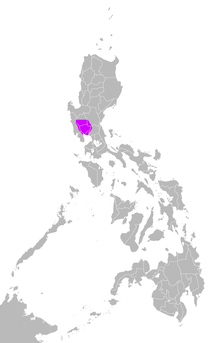This article includes a list of general references, but it lacks sufficient corresponding inline citations. (June 2019) |
| Kapampangan | |
|---|---|
| Pampangan Capampáñgan | |
| Amánung Kapangpángan, Amánung Sísuan | |
 Kapangpángan written in Kulitan, the language's indigenous writing system | |
| Pronunciation | [kəːpəmˈpaːŋən] |
| Native to | Philippines |
| Region | Central Luzon (entirety of Pampanga, southern Tarlac, northeastern Bataan, western Bulacan, southwestern Nueva Ecija, southeastern parts of Zambales) |
| Ethnicity | Kapampangan |
Native speakers | 2.8 million (2010)[1][needs update] 7th most spoken native language in the Philippines[2] |
| Latin (Kapampangan alphabet) Kulitan | |
| Official status | |
Official language in | Angeles City[3][4][5] |
Recognised minority language in | Regional language of the Philippines |
| Regulated by | Komisyon sa Wikang Filipino |
| Language codes | |
| ISO 639-2 | pam |
| ISO 639-3 | pam |
| Glottolog | pamp1243 |
 Areas where Kapampangan is spoken in the Philippines | |
Kapampangan, Capampáñgan, or Pampangan is an Austronesian language, and one of the eight major languages of the Philippines. It is the primary and predominant language of the entire province of Pampanga and southern Tarlac, on the southern part of Luzon's central plains geographic region, where the Kapampangan ethnic group resides. Kapampangan is also spoken in northeastern Bataan, as well as in the provinces of Bulacan, Nueva Ecija, and Zambales that border Pampanga. It is further spoken as a second language by a few Aeta groups in the southern part of Central Luzon.[6] The language is known honorifically as Amánung Sísuan ('breastfed, or nurtured, language').[7]
Kapampangan is assigned the ISO 639-2 three-letter code pam, but not an ISO 639-1 two-letter code.
- ^ "2010 Census of Population and Housing, Report No. 2A - Demographic and Housing Characteristics (Non-Sample Variables)" (PDF). Retrieved 2022-05-02.
- ^ "2010 Census of Population and Housing, Report No. 2A - Demographic and Housing Characteristics (Non-Sample Variables)" (PDF). Retrieved 2022-05-02.
- ^ Ordinance No. 424, City of Angeles.
- ^ Orejas, Tonette (July 22, 2021). "Angeles traffic signs soon in Kapampangan". The Philippine Daily Inquirer. Retrieved September 7, 2021.
- ^ Orejas, Tonette (September 7, 2021). "Drivers welcome Kapampangan traffic signs". The Philippine Daily Inquirer. Retrieved September 7, 2021.
- ^ Eberhard, David M.; Simons, Gary F.; Fennig, Charles D., eds. (2021). "Kapampangan". Ethnologue: Languages of the World (24th ed.). Dallas, Texas: SIL International. Archived from the original on 2021-09-22. Retrieved 2 September 2021.
- ^ Ulrich Ammon; Norbert Dittmar; Klaus J. Mattheier (2006). Sociolinguistics: an international handbook of the science of language and society. Vol. 3. Walter de Gruyter. p. 2018. ISBN 978-3-11-018418-1.